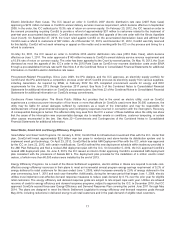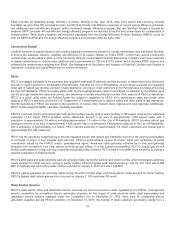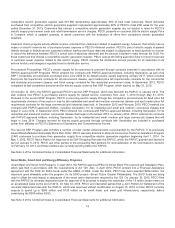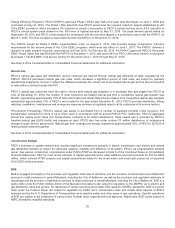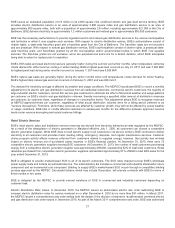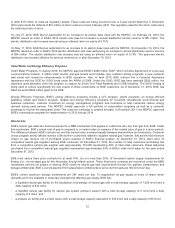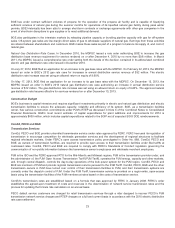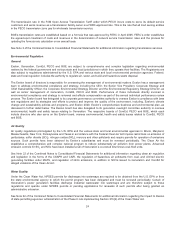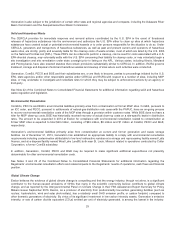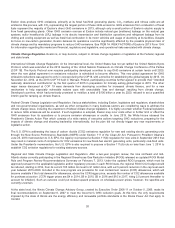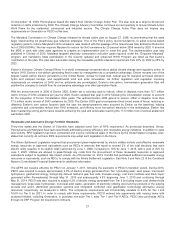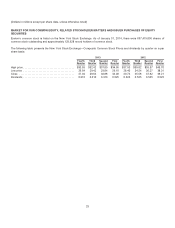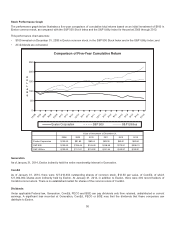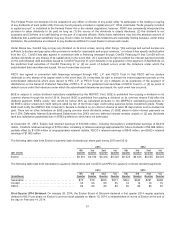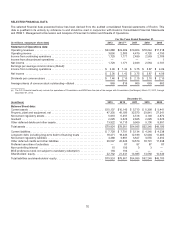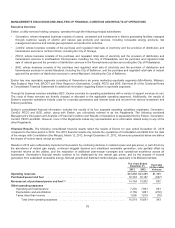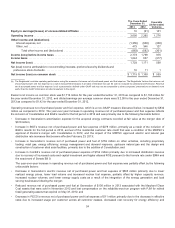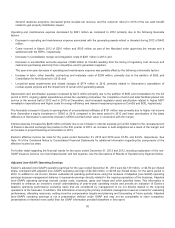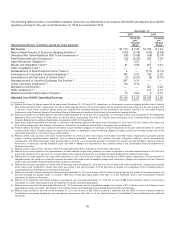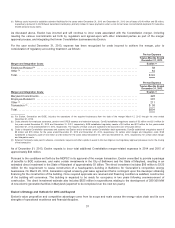ComEd 2013 Annual Report Download - page 33
Download and view the complete annual report
Please find page 33 of the 2013 ComEd annual report below. You can navigate through the pages in the report by either clicking on the pages listed below, or by using the keyword search tool below to find specific information within the annual report.OnDecember 18, 2009, Pennsylvaniaissuedthestate’s final Climate ChangeAction Plan.The plan setsasa target a 30 percent
reduction inGHG emissionsby2020.TheClimate ChangeAdvisoryCommittee continuesto meet quarterlyto reviewClimate Action
WorkPlansfor theresidential,commercial andindustrial sectors. TheClimate ChangeAction Plan doesnot imposeany
requirementson Generation or PECO at this time.
TheMarylandCommission on Climate Change releaseditsclimate action plan on August27, 2008, recommendingthat thestate
beginimplementing42greenhousegasreduction strategies. One ofthePlan’s policy recommendations, to adopt science-based
regulatorygoalsto reduceMaryland’s GHG emissions, wasrealizedwiththepassageoftheGreenhouseGas EmissionsReduction
Actof2009 (GGRA). ThelawrequiresMarylandto reduceits GHG emissionsby25percent below2006levelsby2020.Itdirected
theMDE to workwithother state agenciesto prepare an implementation plan to meet this goal.Theimplementation plan was
publishedinOctober of2013.Marylandtargetedelectricityconsumption reduction goalsrequiredunder the“Empower Maryland”
program, andmandatoryState participation intherecentlyupdatedandenhancedRGGI Programare listedasthat sector’s
contribution inthe plan.The plan alsoadvocatesraisingthe renewable portfoliostandardrequirement from22%by2022 to 25% by
2022.
Exelon’s Voluntary Climate Change Efforts.Inaworldincreasinglyconcernedabout global climate changeandregulatoryaction to
reduceGHG, Exelon’s low-carbon generatingfleet is seen by management asacompetitiveadvantage.Exelon remainsone ofthe
largest,lowestcarbon electric generatorsintheUnitedStates: nuclear for base load, natural gasfor marginal andpeakdemand,
hydro andpumpedstorage,andsupplemental windandsolar renewables. Asfurther legislation andregulation imposing
requirementson emissionsof GHG andair pollutantsare promulgated, Exelon’s low-carbon,low-emission generation fleet will
position thecompanyto benefitfromitscomparativeadvantageover other generation fleets.
Withthe announcement in 2008ofExelon 2020,Exelon set a voluntarygoal to reduce,offset or displacemore than 15.7 million
metric tonnesof GHG emissionsper year by 2020.Exelon updatedthat goal in 2012 followingtheConstellation merger to account
for theintegration offormer Constellation GHG goals. TheupdatedExelon 2020 goal is to reduce,offset or displacemore than
17.5 million metric tonnesof GHG emissionsby2020.TheExelon 2020 goal encompassesthree broadareasoffocus: reducingor
offsettingExelon’s owncarbon footprint (withtheyear theasset/operationswere acquiredbyExelon asthebaseline), helping
customersandcommunitiesreducetheirGHG emissions, andofferingmore low-carbon electricityinthemarketplace.Exelon has
been maintainingstrongperformancetowards achievingthegoal andanticipatesreachingthe17.5 million tonsofannual abatement
well before 2020.
Renewable and Alternative Energy Portfolio Standards
Thirty-nine statesandtheDistrictofColumbiahaveadoptedsomeformofRPS requirement.Aspreviouslydescribed, Illinois,
PennsylvaniaandMarylandhavelaws specificallyaddressingenergy efficiency andrenewable energy initiatives. Inaddition to state
level activity, RPS legislation hasbeen consideredandmaybeconsideredagaininthefuture by theUnitedStatesCongress. Also,
statesthat currentlydo not haveRPS requirementsmayadopt such legislation inthefuture.
TheIllinois Settlement Legislation requiredthat procurement plansimplementedbyelectric utilitiesincludecost-effective renewable
energy resourcesor approvedequivalentssuch asRECs inamountsthat equal or exceed2%ofthe total electricitythat each
electric utilitysuppliesto itseligible retailcustomersbyJune 1,2008, increasingto 10%byJune 1,2015, withagoal of25% by
June 1,2025. Utilitiesare allowedto pass-through anycostsfromthe procurement ofthese renewable resourcesor approved
equivalentssubjecttolegislatedrate impactcriteria.AsofDecember 31,2013,ComEd hadpurchasedsufficient renewable energy
resourcesor equivalents, such asRECs, to complywiththeIllinois Settlement Legislation.See Note 3 andNote 22 oftheCombined
Notesto ConsolidatedFinancial Statementsfor additional information.
TheAEPS Actbecameeffectivefor PECO on January1,2011,followingtheexpiration of PECO’s transition period. During2013,
PECO wasrequiredto supplyapproximately4.0%ofelectric energy generatedfromTier I(includingsolar,windpower,low-impact
hydropower,geothermal energy, biologicallyderivedmethane gas, fuel cells, biomass energy, coal mine methane andblack liquor
generatedwithinPennsylvania)through May31,2013 andsubsequently 4.5% beginningJune 1,2013 andcontinuingthrough
May31,2014. PECO wasalsorequiredto supply6.2%ofelectric energy generatedfromTier II (includingwaste coal,demand-side
management,large-scale hydropower,municipal solid waste,generation ofelectricityutilizingwoodand by-productsofthe pulping
process andwood, distributedgeneration systems andintegratedcombinedcoal gasification technology) alternative energy
resources, respectively, asmeasuredinAECs. Thecompliancerequirementswill incrementallyescalate to 8.0%for Tier Iand
10.0%for Tier II by 2021.Inorder to complywiththeserequirements, PECO enteredinto agreementswithvaryingterms with
accepted bidders, includingGeneration,to purchase non-solar Tier I, solar Tier 1 andTier II AECs. PECO also purchasesAECs
through its DSP Programfull requirement contracts.
27


